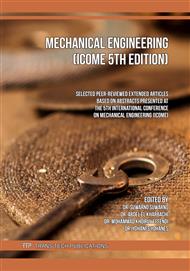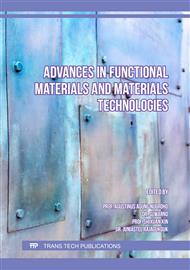[1]
A. V. Hoeylandt and R. Silva-Dias, The world merchant fleet in 2019,, p.104, (2019).
Google Scholar
[2]
Committee V.6 et al., CONDITION ASSESSMENT OF AGED SHIPS AND OFFSHORE STRUCTURES,, in ISSC Committee V.6: Condition Assessment, Seoul, Korea, Sep. 2009, vol. 2. [Online]. Available: https://www.researchgate.net/publication/265199433_CONDITION_ASSESSMENT_OF_AGED_SHIPS_AND_OFFSHORE_STRUCTURES.
DOI: 10.1201/9781439832554.ch13
Google Scholar
[3]
C. Guedes Soares and Y. Garbatov, Reliability of maintained ship hulls subjected to corrosion and fatigue under combined loading,, J. Constr. Steel Res., vol. 52, no. 1, p.93–115, Oct. 1999,.
DOI: 10.1016/s0143-974x(99)00016-4
Google Scholar
[4]
A. Zayed, Y. Garbatov, and C. G. Soares, Reliability of ship hulls subjected to corrosion and maintenance,, Struct. Saf., vol. 43, p.1–11, Jul. 2013,.
DOI: 10.1016/j.strusafe.2013.01.001
Google Scholar
[5]
K. M. Neumann and B. Leira, Time-variant rule-based reliability of corroded structures by Monte Carlo simulation,, Mater. Sci. Eng., p.14, (2019).
DOI: 10.1088/1757-899x/700/1/012036
Google Scholar
[6]
K. Woloszyk and Y. Garbatov, Structural Reliability Assessment of Corroded Tanker Ship Based on Experimentally Estimated Ultimate Strength,, Pol. Marit. Res., vol. 26, no. 2, p.47–54, Jun. 2019,.
DOI: 10.2478/pomr-2019-0024
Google Scholar
[7]
A. Zayed, Y. Garbatov, and C. Guedes Soares, Time variant reliability assessment of ship structures with fast integration techniques,, Probabilistic Eng. Mech., vol. 32, p.93–102, Apr. 2013,.
DOI: 10.1016/j.probengmech.2013.01.002
Google Scholar
[8]
C. Gong, D. M. Frangopol, and M. Cheng, Risk-based life-cycle optimal dry-docking inspection of corroding ship hull tankers,, Eng. Struct., vol. 195, p.559–567, Sep. 2019,.
DOI: 10.1016/j.engstruct.2019.05.063
Google Scholar
[9]
A. Decò and D. M. Frangopol, Real-time risk of ship structures integrating structural health monitoring data: Application to multi-objective optimal ship routing,, Ocean Eng., vol. 96, p.312–329, Mar. 2015,.
DOI: 10.1016/j.oceaneng.2014.12.020
Google Scholar
[10]
Y. Liu, D. M. Frangopol, and M. Cheng, Risk-informed structural repair decision making for service life extension of aging naval ships,, Mar. Struct., vol. 64, p.305–321, Mar. 2019,.
DOI: 10.1016/j.marstruc.2018.10.008
Google Scholar
[11]
Y. Dong and D. M. Frangopol, Risk-informed life-cycle optimum inspection and maintenance of ship structures considering corrosion and fatigue,, Ocean Eng., vol. 101, p.161–171, Jun. 2015,.
DOI: 10.1016/j.oceaneng.2015.04.020
Google Scholar
[12]
G. Wang, J. S. Spencer, S. Saidarasamoot, S. Thuanboon, D. L. Olson, and B. Mishra, Tanker Corrosion,, in Handbook of Environmental Degradation of Materials, Elsevier, 2012, p.799–832.
DOI: 10.1016/b978-1-4377-3455-3.00026-2
Google Scholar
[13]
J. Guo, G. Wang, L. Ivanov, and A. N. Perakis, Time-varying ultimate strength of aging tanker deck plate considering corrosion effect,, Mar. Struct., vol. 21, no. 4, p.402–419, Oct. 2008,.
DOI: 10.1016/j.marstruc.2008.03.002
Google Scholar
[14]
Ship inspection | Hull integrity | ShipManager Hull,, DNV GL. https://www.dnvgl.com/services/hull-integrity-and-ship-maintenance-software-shipmanager-hull-1531 (accessed Feb. 13, 2021).
Google Scholar
[15]
Dr. B. M. Ayyub, U. O. Akpan, G. F. DeSouza, T. S. Koko, and X. Luo, Ship Structure Committee: Risk-Based Life Cycle Management of Ship Structures,, Ship Structure Committee, Washington DC, Technical Report SSC-416, Nov. 2001. Accessed: Feb. 25, 2021. [Online]. Available: http://www.shipstructure.org/pdf/416.pdf.
Google Scholar
[16]
W. Sahasakkul, A. Arablouei, and A. Sari, Comparison of Fatigue Calculations Methods for Structural Integrity Assessment of Offshore Structures,, in Day 1 Mon, May 02, 2016, Houston, Texas, USA, May 2016, p. D011S012R007.
DOI: 10.4043/27216-ms
Google Scholar
[17]
O. Ozguc, Fatigue assessment of FPSO hull side shell longitudinals using component stochastic and full spectral method,, Appl. Ocean Res., vol. 101, p.102289, Aug. 2020,.
DOI: 10.1016/j.apor.2020.102289
Google Scholar
[18]
American Bureau of Shipping, Guide for Fatigue Assessment of Offshore Structures., American Bureau of Shipping, Jun. 01, 2020. Accessed: Mar. 06, 2021. [Online]. Available: https://ww2.eagle.org/content/dam/eagle/rules-and-guides/current/offshore/115_fatigueassessmentofoffshorestructures/offshore-fatigue-guide-jun20.pdf.
DOI: 10.3940/rina.icsot.2006.14
Google Scholar
[19]
G. Wang, J. Spencer, and T. Elsayed, Estimation of Corrosion Rates of Structural Members in Oil Tankers,, in Volume 3: Materials Technology; Ocean Engineering; Polar and Arctic Sciences and Technology; Workshops, Cancun, Mexico, Jan. 2003, p.253–258.
DOI: 10.1115/omae2003-37361
Google Scholar
[20]
C. N. Agarwala, Corrosion Predictive Modeling for Aging Ships,, p.8.
Google Scholar
[21]
M. Ilahi, S. Kar, K. Mukherjee, and M. S. B. Ayob, Risk Based Integrity Management System for FLNG Hull Structure,, presented at the Offshore Technology Conference Asia, Kuala Lumpur, Malaysia, 2016.
DOI: 10.4043/26801-ms
Google Scholar
[22]
F. Guédé, Risk-based structural integrity management for offshore jacket platforms,, Mar. Struct., vol. 63, p.444–461, Jan. 2019,.
DOI: 10.1016/j.marstruc.2018.04.004
Google Scholar
[23]
Strength assessment of hull structures – POSEIDON,, DNV. https://www.dnv.com/services/strength-assessment-of-hull-structures-poseidon-18518 (accessed Mar. 12, 2021).
Google Scholar
[24]
C. Gong and D. M. Frangopol, System reliability of corroded ship hull girders,, Struct. Infrastruct. Eng., vol. 16, no. 9, p.1302–1310, Sep. 2020,.
DOI: 10.1080/15732479.2019.1703761
Google Scholar
[25]
G. Feng, B. Hu, and H. Ren, Reliability of the ultimate strength of ship stiffened panel subjected to random corrosion degradation,, China Ocean Eng., vol. 31, no. 1, p.11–18, Mar. 2017,.
DOI: 10.1007/s13344-017-0002-9
Google Scholar
[26]
Dr. B. M. Ayyub, U. O. Akpan, P. A. Rushton, T. S. Koko, J. Ross, and J. Lua, Ship Structure Committee: Risk-Informed Inspection of Marine Vessels,, Ship Structure Committee, Wahington Dc, Technical Report SSC-421, Aug. 2002. Accessed: Mar. 08, 2021. [Online]. Available: http://www.shipstructure.org/pdf/421.pdf.
Google Scholar



